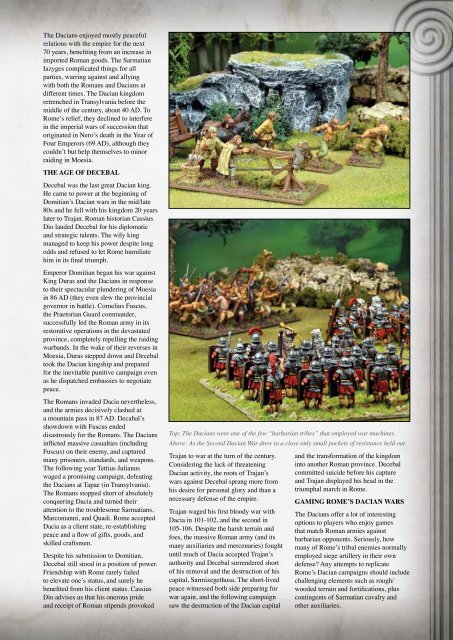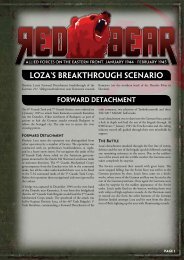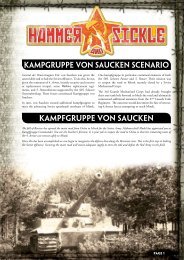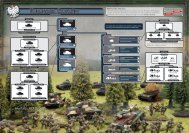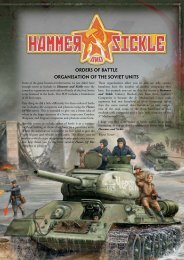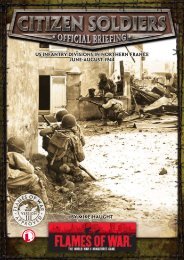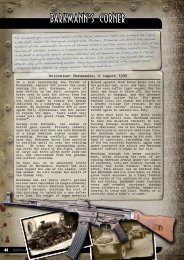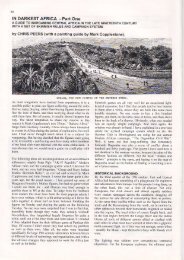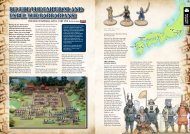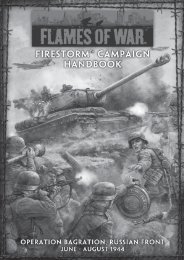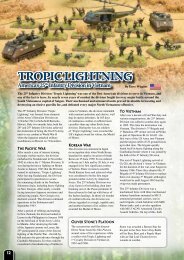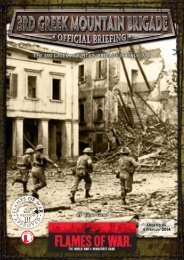Download a PDF version of this article here - Flames of War
Download a PDF version of this article here - Flames of War
Download a PDF version of this article here - Flames of War
Create successful ePaper yourself
Turn your PDF publications into a flip-book with our unique Google optimized e-Paper software.
The Dacians enjoyed mostly peaceful<br />
relations with the empire for the next<br />
70 years, benefiting from an increase in<br />
imported Roman goods. The Sarmatian<br />
Iazyges complicated things for all<br />
parties, warring against and allying<br />
with both the Romans and Dacians at<br />
different times. The Dacian kingdom<br />
retrenched in Transylvania before the<br />
middle <strong>of</strong> the century, about 40 AD. To<br />
Rome’s relief, they declined to interfere<br />
in the imperial wars <strong>of</strong> succession that<br />
originated in Nero’s death in the Year <strong>of</strong><br />
Four Emperors (69 AD), although they<br />
couldn’t but help themselves to minor<br />
raiding in Moesia.<br />
ThE AGE Of DECEBAL<br />
Decebal was the last great Dacian king.<br />
He came to power at the beginning <strong>of</strong><br />
Domitian’s Dacian wars in the mid/late<br />
80s and he fell with his kingdom 20 years<br />
later to Trajan. Roman historian Cassius<br />
Dio lauded Decebal for his diplomatic<br />
and strategic talents. The wily king<br />
managed to keep his power despite long<br />
odds and refused to let Rome humiliate<br />
him in its final triumph.<br />
Emperor Domitian began his war against<br />
King Duras and the Dacians in response<br />
to their spectacular plundering <strong>of</strong> Moesia<br />
in 86 AD (they even slew the provincial<br />
governor in battle). Cornelius Fuscus,<br />
the Praetorian Guard commander,<br />
successfully led the Roman army in its<br />
restorative operations in the devastated<br />
province, completely repelling the raiding<br />
warbands. In the wake <strong>of</strong> their reverses in<br />
Moesia, Duras stepped down and Decebal<br />
took the Dacian kingship and prepared<br />
for the inevitable punitive campaign even<br />
as he dispatched embassies to negotiate<br />
peace.<br />
The Romans invaded Dacia nevertheless,<br />
and the armies decisively clashed at<br />
a mountain pass in 87 AD. Decabal’s<br />
showdown with Fuscus ended<br />
disastrously for the Romans. The Dacians<br />
inflicted massive casualties (including<br />
Fuscus) on their enemy, and captured<br />
many prisoners, standards, and weapons.<br />
The following year Tettius Julianus<br />
waged a promising campaign, defeating<br />
the Dacians at Tapae (in Transylvania).<br />
The Romans stopped short <strong>of</strong> absolutely<br />
conquering Dacia and turned their<br />
attention to the troublesome Sarmatians,<br />
Marcomanni, and Quadi. Rome accepted<br />
Dacia as a client state, re-establishing<br />
peace and a flow <strong>of</strong> gifts, goods, and<br />
skilled craftsmen.<br />
Despite his submission to Domitian,<br />
Decebal still stood in a position <strong>of</strong> power.<br />
Friendship with Rome rarely failed<br />
to elevate one’s status, and surely he<br />
benefited from his client status. Cassius<br />
Dio advises us that his onerous pride<br />
and receipt <strong>of</strong> Roman stipends provoked<br />
Top: The Dacians were one <strong>of</strong> the few “barbarian tribes” that employed war machines.<br />
Above: As the Second Dacian <strong>War</strong> drew to a close only small pockets <strong>of</strong> resistance held out.<br />
Trajan to war at the turn <strong>of</strong> the century.<br />
Considering the lack <strong>of</strong> threatening<br />
Dacian activity, the roots <strong>of</strong> Trajan’s<br />
wars against Decebal sprang more from<br />
his desire for personal glory and than a<br />
necessary defense <strong>of</strong> the empire.<br />
Trajan waged his first bloody war with<br />
Dacia in 101-102, and the second in<br />
105-106. Despite the harsh terrain and<br />
foes, the massive Roman army (and its<br />
many auxiliaries and mercenaries) fought<br />
until much <strong>of</strong> Dacia accepted Trajan’s<br />
authority and Decebal surrendered short<br />
<strong>of</strong> his removal and the destruction <strong>of</strong> his<br />
capital, Sarmizegethusa. The short-lived<br />
peace witnessed both side preparing for<br />
war again, and the following campaign<br />
saw the destruction <strong>of</strong> the Dacian capital<br />
and the transformation <strong>of</strong> the kingdom<br />
into another Roman province. Decebal<br />
committed suicide before his capture<br />
and Trajan displayed his head in the<br />
triumphal march in Rome.<br />
GAMING ROME’S DACIAN WARS<br />
The Dacians <strong>of</strong>fer a lot <strong>of</strong> interesting<br />
options to players who enjoy games<br />
that match Roman armies against<br />
barbarian opponents. Seriously, how<br />
many <strong>of</strong> Rome’s tribal enemies normally<br />
employed siege artillery in their own<br />
defense? Any attempts to replicate<br />
Rome’s Dacian campaigns should include<br />
challenging elements such as rough/<br />
wooded terrain and fortifications, plus<br />
contingents <strong>of</strong> Sarmatian cavalry and<br />
other auxiliaries.


